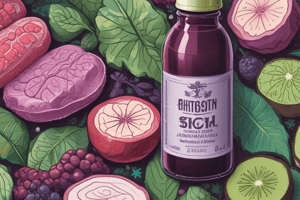Podcast
Questions and Answers
What increases the antioxidant enzyme activity in tea leaves treated with chitosan NPs?
What increases the antioxidant enzyme activity in tea leaves treated with chitosan NPs?
- Higher application rates of water
- Genetic modification of the plants
- Increased expression of defense-related genes (correct)
- Application of synthetic fertilizers
Which antimicrobial activities have been attributed to Cu-chitosan NPs?
Which antimicrobial activities have been attributed to Cu-chitosan NPs?
- Promotion of photosynthesis
- Inhibition of nitrogen-fixing bacteria
- Control of bacterial wilt and root rot
- Control of early blight and Fusarium wilt (correct)
What is associated with the enhanced plant growth promotion observed with chitosan NPs?
What is associated with the enhanced plant growth promotion observed with chitosan NPs?
- Increased plant age
- Reduction in sunlight exposure
- Presence of harmful bacteria
- Unique physicochemical characteristics of chitosan NPs (correct)
Which of the following aspects of seedling growth is NOT mentioned as being improved by chitosan NPs?
Which of the following aspects of seedling growth is NOT mentioned as being improved by chitosan NPs?
What factors contribute to the successful application of chitosan NPs in plant growth promotion?
What factors contribute to the successful application of chitosan NPs in plant growth promotion?
What is one effect of treating plants with chitosan NPs as observed in studies?
What is one effect of treating plants with chitosan NPs as observed in studies?
What characteristic of chitosan NPs aids in their effective delivery as a treatment to plants?
What characteristic of chitosan NPs aids in their effective delivery as a treatment to plants?
Which of the following statements is true regarding the synthesis of Cu-chitosan NPs?
Which of the following statements is true regarding the synthesis of Cu-chitosan NPs?
What is a significant benefit of using chitosan-based nanomaterials in plant growth?
What is a significant benefit of using chitosan-based nanomaterials in plant growth?
Which nutrient encapsulated by chitosan is essential for crop improvement?
Which nutrient encapsulated by chitosan is essential for crop improvement?
How does chitosan contribute to increased seedling vigor?
How does chitosan contribute to increased seedling vigor?
What role does nano-technology play in nutrient delivery via chitosan?
What role does nano-technology play in nutrient delivery via chitosan?
Which of the following statements is false regarding chitosan's function as a nitrogen source?
Which of the following statements is false regarding chitosan's function as a nitrogen source?
What is one environmental application of chitosan mentioned in the content?
What is one environmental application of chitosan mentioned in the content?
What is the main reason researchers are interested in chitosan for agriculture?
What is the main reason researchers are interested in chitosan for agriculture?
Which of the following effects does chitosan NOT have on plants?
Which of the following effects does chitosan NOT have on plants?
What is a significant benefit of using chitosan nanomaterial in agriculture?
What is a significant benefit of using chitosan nanomaterial in agriculture?
Which of the following enzymes is NOT directly associated with the defense response enhanced by chitosan treatment?
Which of the following enzymes is NOT directly associated with the defense response enhanced by chitosan treatment?
How does chitosan affect the synthesis of cell wall material in plants?
How does chitosan affect the synthesis of cell wall material in plants?
What role does chitosan play in the enhancement of antioxidant enzyme activity?
What role does chitosan play in the enhancement of antioxidant enzyme activity?
What is a primary physiological response induced by chitosan in plants?
What is a primary physiological response induced by chitosan in plants?
In what way does chitosan contribute to protecting plants from pathogens?
In what way does chitosan contribute to protecting plants from pathogens?
Which is an incorrect statement about chitosan nanomaterial's applications?
Which is an incorrect statement about chitosan nanomaterial's applications?
What is the impact of coencapsulation of Cu and SA with chitosan on maize?
What is the impact of coencapsulation of Cu and SA with chitosan on maize?
Flashcards
Chitosan Nanomaterial
Chitosan Nanomaterial
A type of nanomaterial derived from chitosan, a natural polymer, used to improve plant nutrient delivery and growth.
Chitosan NPs (Nanoparticles)
Chitosan NPs (Nanoparticles)
Small particles of chitosan, a natural polymer, used to improve plant health and growth.
Nutrient Use Efficiency
Nutrient Use Efficiency
The effectiveness of a plant in taking up and using available nutrients for growth.
Defense Enzyme Activity
Defense Enzyme Activity
Signup and view all the flashcards
Antioxidant Enzymes
Antioxidant Enzymes
Signup and view all the flashcards
Seedling Growth
Seedling Growth
Signup and view all the flashcards
Nano-nutrients
Nano-nutrients
Signup and view all the flashcards
Secondary Metabolites
Secondary Metabolites
Signup and view all the flashcards
Seed Priming/Treatment
Seed Priming/Treatment
Signup and view all the flashcards
Nano-encapsulation
Nano-encapsulation
Signup and view all the flashcards
Chitosan as a Nitrogen Source
Chitosan as a Nitrogen Source
Signup and view all the flashcards
Seedling Growth
Seedling Growth
Signup and view all the flashcards
Food Mobilizing Enzymes
Food Mobilizing Enzymes
Signup and view all the flashcards
Plant Growth Promoter
Plant Growth Promoter
Signup and view all the flashcards
Fungal Diseases
Fungal Diseases
Signup and view all the flashcards
Cu-chitosan NPs
Cu-chitosan NPs
Signup and view all the flashcards
Cu-chitosan NPs
Cu-chitosan NPs
Signup and view all the flashcards
Plant Yield
Plant Yield
Signup and view all the flashcards
SA and Cu coencapsulated chitosan nanofertilizer
SA and Cu coencapsulated chitosan nanofertilizer
Signup and view all the flashcards
Source activity
Source activity
Signup and view all the flashcards
Sink strength
Sink strength
Signup and view all the flashcards
Chitosan nanomaterial
Chitosan nanomaterial
Signup and view all the flashcards
Reactive oxygen species (ROS)
Reactive oxygen species (ROS)
Signup and view all the flashcards
Antioxidant enzymes
Antioxidant enzymes
Signup and view all the flashcards
Seed priming
Seed priming
Signup and view all the flashcards
Foliar application
Foliar application
Signup and view all the flashcards
Lignin deposition
Lignin deposition
Signup and view all the flashcards
Study Notes
Chitosan Nanomaterials for Plant Delivery of Micronutrients
- Global population increase demands a 70% rise in food production by 2050, increasing the importance of crop yield.
- Micronutrients are crucial for optimal plant development and yield.
- Conventional fertilizers have low (40%) micronutrient use efficiency, creating environmental and health problems.
- Nanotechnology offers an alternative approach to improve nutrient delivery, plant immunity, and growth.
- Metal-based nanomaterials are widely used in agriculture, but their phytotoxicity is a concern.
- Chitosan-based nanomaterials are desirable due to biocompatibility, biodegradability, antimicrobial activity, and non-toxicity.
Chitosan Nonmaterial and Their Application
- Chitosan is a deacetylated form of chitin, a natural polymer found in fungi, crustaceans, and insect cuticles.
- Chitosan exhibits biocompatibility, biodegradability, antimicrobial activity, and non-toxicity, making it suitable for various applications, including antifungal and antibacterial activity, and plant growth promotion.
- Chitosan-based nanomaterials offer controlled and sustained release of nutrients for improved plant uptake.
- Higher plant growth is achieved through vigorous seedling establishment and enhanced nutrient utilization.
Use of Chitosan Nanomaterials for Nutrient Supply
- Chitosan nanomaterials enhance nutrient supply, leading to higher germination, root length, root number, and biomass.
- This technology improves the efficiency of micronutrient uptake by plants, addressing deficiencies and enhancing overall plant health.
- Chitosan nanofertilizers improve plant resistance to biotic and abiotic stresses.
- Chitosan enhances food mobilizing enzymes (amylase and protease) in plants.
Various Chitosan-Based Nanomaterials
- Chitosan exhibits antimicrobial activity against plant and animal microbes, but its aqueous insolubility limits its use.
- Chitosan is made more effective by modifying its physicochemical properties, such as enhancing its dispersion in aqueous media, to improve its antimicrobial and growth-promoting activities.
- Chitosan-tripolyphosphate (TPP) cross-links improve nanoparticle properties like size, size distribution, and surface charge.
- Chitosan has strong chelating properties, making it ideal as an encapsulating agent for metals and signaling molecules, like salicylic acid (SA).
Copper-Chitosan Nanomaterial
- Copper is an essential micronutrient in plants, vital for several enzymatic processes and electron transport.
- Copper-chitosan nanoparticles enhance plant growth and defense mechanisms.
- These nanoparticles release copper slowly, mitigating toxicity and maximizing effectiveness.
- They improve activity of antioxidant and defense enzymes contributing to overall plant health.
Zinc-Chitosan Nanomaterials
- Zinc is essential for plant growth and development.
- Zinc deficiency in soils negatively impacts plant growth, yield, and susceptibility to diseases.
- Zinc-chitosan nanoparticles provide a slow-release system for zinc, preventing deficiencies and enhancing plant health.
- These nanoparticles have shown effectiveness in increasing yield and resistance against plant diseases.
Salicylic Acid (SA)-Chitosan Nanomaterials
- Salicylic acid (SA) is a naturally occurring plant hormone that plays a crucial role in plant defense responses.
- SA-chitosan nanoparticles enhance plant defense mechanisms by increasing the activities of antioxidant enzymes.
- These nanoparticles facilitate the sustained release of SA into plants, improving their resistance against diseases.
- SA-chitosan nanoparticles improve growth and yield of plants, thus enhancing productivity.
Chitosan Nanomaterial in Plant Growth
- Chitosan-based nanomaterials, with their unique properties, are used to promote plant growth.
- Nanochitosan improves various aspects of plant growth like seedling development, plant height, leaf area, nutrient uptake, and photosynthesis.
- Chitosan has enhanced defence mechanisms for plant growth by increasing activities of antioxidant and defense enzymes.
- The targeted release of nutrients from chitosan nanoparticles leads to higher yield under nanofertilizer treatments.
Plant Growth and Nutrition
- Chitosan-based nanomaterials positively affect plant growth and development, leading to enhanced nutrient use efficiency.
- Increased nutrient availability and uptake result in higher crop yield and improved plant health.
- The use of chitosan as a base matrix for co-encapsulation of multiple valuable components is a novel approach for more efficient nutrient delivery.
Studying That Suits You
Use AI to generate personalized quizzes and flashcards to suit your learning preferences.




